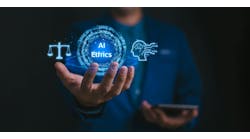The journey forward for the leaders of U.S. patient care organizations remains clouded by immediate uncertainty, because of the impact of the COVID-19 pandemic. But even beyond the immediate challenges of the coronavirus on patient care delivery, hospital, medical group, and health system leaders are finding it challenging to try to peer into the next few years in U.S. healthcare and figure out how to execute on strategic planning right now.
One industry leader who has a perspective on this is Liam Bouchier, a principal in the Naperville, Illinois-based Impact Advisors consulting firm. Recently, the New Orleans-based Bouchier spoke with Healthcare Innovation Editor-in-Chief Mark Hagland on the cornucopia of issues facing strategic planners in U.S. healthcare—and the foundational role that the leveraging of data analytics and the use of artificial intelligence (AI) will play, in that ongoing journey. Below are excerpts from their interview.
Looking at this moment in U.S. healthcare, where would you say that we are, in the journey of a thousand miles around data analytics and artificial intelligence?
At the highest level, you need a couple of factors to be key ingredients around massive scale change in healthcare. When we talk about AI and predictive and prescriptive analytics, those are all still in the nascent stage. But all were triggered by the ARRA recovery act [the American Recovery and Reinvestment Act of 2009] and the HITECH Act [the Health Information Technology and for Economic and Clinical Health Act, which formed part of the ARRA], investment by the government in HIT, and an economic downturn. Fast-forward to 2020, and we’re seeing a number of things. First, health systems have shared information—you need to know about people to manage their health, and health systems have started to share information. So the HITECH Act enabled that.
That was the initial trigger. And now in 2020, we’ve had similar factors operating. We’ve had the 21st-Century CURES Act [whose information technology provisions defined interoperability and forbade information-blocking], putting information in the hands of the consumer, and designed to stop information-blocking; that’s the next level of information-sharing. And hopefully, people will read the terms and conditions on the apps. But you’ve got more vendors having access to health information. And you’ve got the economic downturn and government stimulus. But the new thing is, you’ve got demand.
Think about what’s happened in the past several months: the restrictions on telehealth adoption were removed, so providers can practice across state lines; a whole series of codes that CMS introduced, increased uptake. And what health systems discovered is that we actually have a population that will adopt the technologies as long as they’re available.
So in five years’ time, predictive analytics around population health and operations, will be how we operate on a daily basis: you’ll know the risk of someone’s hospitalization from heart failure, the risk of someone with hypertension, the risk of someone being readmitted, or of not showing up. Those factors will be in place and there will be enough information on populations to drive value-based contracting.
What we’ll still be working on five years from now will be around prescriptive analytics. You’ll have workflow and process that you can predict and modify before it occurs. Right now, it’s being used for things like bed surge crunches, and such. And as an engineer, I would agree with that. But you’ll have a diabetic who has a risk of some negative outcomes, and so first, information will be collected on their phone or other mobile device; second, some corrective action will be taken; and third, if it’s something life-threatening, a team will be deployed. So I think that’s where we’re going to be.
And especially on the revenue cycle side and on the decision support side, there’s still a lot of manual processes, and those will benefit from robotic process automation. And in terms of the tools involved, if you think of HITECH and EMRs and the Cures Act, and the digital interfaces that have been built for patients, I think it will be about enterprise resource planning. COVID was the first time… I’m on the analytics service line at Impact; and in the last few months, every single health system in the country had to agree on metrics, had to work on data definitions and sources, in ways they’d never done before. People had never had to think about supply chain, resourcing, ED metrics, bed metrics, in that organized way.
And the difference now is that there are processes that are involved now, too?
Yes, blockages are being removed. Look at data governance—that’s moving forward. And it doesn’t need to be complicated; you don’t need to do it for the entire organization; that’s something I always emphasize to clients—you don’t need to put data governance in place for the whole organization. Start with COVID. You have the motivator; and that’s exactly what happened. So for me, it’s just fantastic. If there’s a positive outcome from all this, it’s that. But the cool thing is and the interesting thing is the path from the HITECH Act to the CARES Act—it will be ERP systems, customer relationship management systems—and in four or five years, those will be assumed. You’ll have EMRs, you’ll have ways of communicating with the consumer as you have in other industries. It’s not a coincidence that you go to a website and you get an email five minutes later that’s connected to what you just searched.
And when people talk about digital, they talk about a frictionless experience. If you can give me the Amazon experience or the Zappos experience, that’s what consumers are looking for, given that of course healthcare is more complex. Healthcare doesn’t need to do it all by themselves. That’s one of the lessons that’s been learned as well. The Amazons, Microsofts, Googles, are ahead of us in terms of the predictive models they have from consumers, how they market to consumers—why not learn from that? And HC has traditionally tried to do everything by itself. It’s not a sensible way to grow and keep up with the emerging trends. But COVID has helped everyone learn in HC, including in terms of all the industries that wanted to help.
How should CIOs and CMIOs think through the jumble of choices available to them in terms of predictive, prescriptive analytics, and AI?
If you’re a CIO, it’s having your systems and foundations in order first—understanding if you have any gaps there—so, the integration of your delivery system, and the infrastructure that supports it. Is it where it needs to be? And that’s the foundation. And it includes telehealth. But I don’t think everybody should go crazy investing in telehealth—they should think carefully. That’s something that health systems could learn from this pandemic crisis: you really have to know your population, and have to know the people who live in your region. And that’s what happened with the virus: people just came, they weren’t necessarily previously a part of those system. So you need all the typical social determinants of health factors about your population. That’s probably the most critical thing, because that will give you a path, will be the journey to what types of services you need to develop for people, and how you can continue to interact with them; those are the two things, really.


